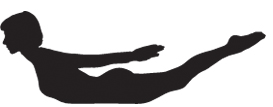12 Basic Asanas
Locust - Shalabhasana
- Headstand (Sirshasana)
- Shoulderstand (Sarvangasana)
- Plough (Halasana)
- Fish (Matsyasana)
- Sitting Forward bend (Paschimothanasana)
- Cobra (Bhujangasana)
- Locust (Shalabhasana)
- Bow (Dhanurasana)
- Spinal twist (Ardha Matsyendrasana)
- Crow (Kakasana) or Peacock (Mayurasana)
- Standing forward bend (Pada Hasthasana)
- Triangle (Trikonasana)

Definition: Lying face down with lifted legs.
Step 1 - Face Down
Lie on your front. Rest your chin on the ground, then move it forward as much as you can, so that your throat lies almost flat. Put your arms by your sides, then push your hands under your body, and make them into fists or clasp them together. Bring your elbows as close together as possible.
Step 2 - Half locust
Inhale as you lift one leg. Hold this position for at least 10 seconds, then exhale while lowering your leg and repeat the pose with your other leg. Practise it 3 times on each side. Chin position: The further forward you push your chin, the more your spine can stretch and the more you will gain from this asana.
Step 3 - Full Locust
Lie with your chin out, as in the Half Locust, then take 3 deep breaths. On the third, lift both legs off the ground. They may not come up far at first, but with practise you may be able to lift them much higher. Hold for as long as you can, then lower your feet. Repeat twice and then relax.
Up and Up: With practise, you will be able to raise your legs higher. Eventually, you may even be able to lift your body vertically.
The Advanced locust
This more difficult pose must be attempted only by experienced students of yoga. The aim, in the advanced asana, is to raise your feet straight up and then lower them over your head. This backward bend compresses your vertebrae while stretching the front of your body to its greatest extent. The strength and flexibility necessary for this pose will eventually develop with regular practise.


